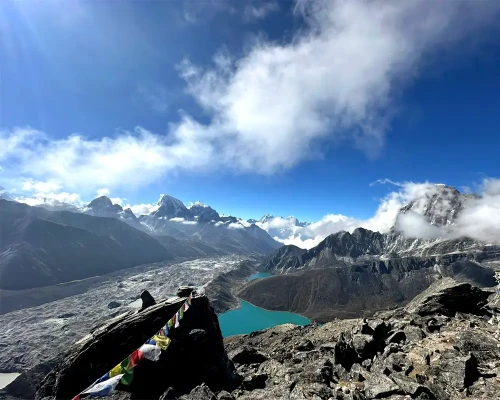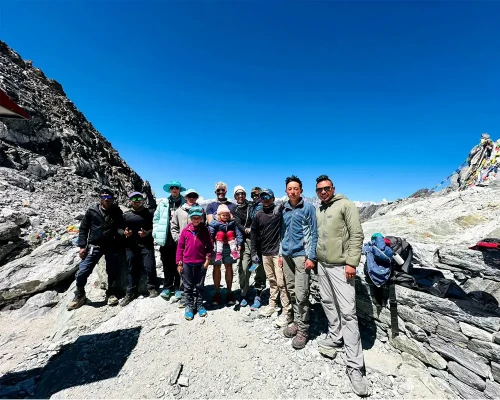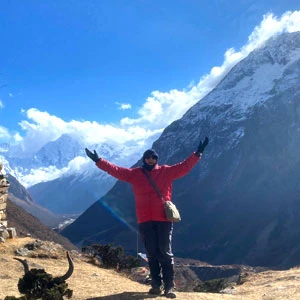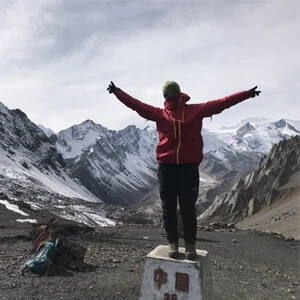Everest Three Passes Trek With Island Peak Climbing
The Everest Three Pass Trek, combined with the Island Peak, is an ultimate Himalayan adventure, perfect for thrill seekers and nature enthusiasts. The highlight of the Everest Three High Pass Trek is the challenge of crossing three high passes: Renjo La Pass (5,388 meters), Cho La Pass (5,380 meters), and Kongma La Pass (5,535 meters). Conquering these passes rewards trekkers with stunning views from Gokyo Ri, Kala Patthar, Chukung Ri, and the Island Peak summit.
The adventure reaches its climax with the exhilarating climb of Island Peak (Imja Tse). The peak has its fair share of challenges as you navigate through its rocky ridges, snowy headwalls, and glaciers. The ultimate reward is the breathtaking panorama of Lhotse (8,516 meters), Peak 38 (7,461 meters), and Baruntse (7,129 meters) from the summit of Island Peak.
Unlike the traditional path, our trek follows an unconventional route, taking the clockwise route from Namche. Out of three passes, on the first pass, we encounter Renjo La and finally conquer Island Peak.
Our adventure starts with an exhilarating 30-minute flight to Lukla (2,840 meters), a tiny town located between the towering peaks of the Himalayas. Next, we head to Namche, a lively village nestled among the mountains; we take a break to adjust to the altitude and enjoy the atmosphere. We explore cozy teahouses, visit the Sherpa Museum, and listen to the soothing sounds of prayer wheels.
On your rest day, your guide takes you to the famous Everest View Hotel. We sip on hot coffee while gazing at the first stunning sight of Mount Everest, Lhotse, Island Peak, Taboche Peak, Ama Dablam, Kangtega, Thamser Ku, Kusum Kanguru, and the holy mountain Khumbila(God of Khumbu) on our hike and feeling its grandeur.
Continuing our journey, we find ourselves between the tranquility of Thame, known for its serene Buddhist monasteries, before venturing into the remote beauty of Lunde. The trail feels somewhat gentler now, but it changes as we approach the first high pass, Renjo La Pass. However, we receive the rewards of alluring views of Everest, Lhotse, Ama Dablam, Makalu, and Cho Latse as we descend to Gokyo Village.
A well-deserved day off allows us to hike to Gokyo Ri, the chance to explore the jaw-dropping views of Mt. Everest, Cho Oyu, Makalu, and Gokyo Lake. Despite that, you can have another mysterious gem: Gokyo has a fifth set of glacial lakes that many of us miss out on. Additionally, you will also have a hike to Dragnag, which allows for rest and acclimatization.
Now comes the second high pass, Cho La Pass, which takes you to Lobuche, where we embark on a trek to Gorak Shep. The anticipation builds as you hike to Everest Base Camp, greeted by the awe-inspiring sight of the world's highest peak. However, the adventure does not stop here as you continue on a sunrise hike to Kala Patthar. The sunlight gleaming on Everest and the neighboring peaks creates a stunning sight. These views can be your strength before conquering the third and most challenging high pass, Kongma La Pass, and descending to Chhukung.
Now, it's time for the ultimate climax as we enjoy a well-deserved rest day in Chhukung, preparing for the goal of our journey: summiting Island Peak. After thorough training from our Sherpa and acclimatization, we trek to Island Peak Base Camp, where we gear up for the exhilarating climb. Finally, summiting the Island Peak rewards us with 360-degree breathtaking views, including Mt. Everest, Lhotse, Ama Dablam, Pumori, and surrounding peaks.
Returning to Namche, we celebrate our accomplishments before continuing to Lukla, reflecting on the experiences gained along the way. Now it is time to end the remarkable journey through the Himalayas and take a flight back to Kathmandu.
Likewise, you may consider similar packages, like the Everest Base Camp Trek with Lobuche Peak Climbing, Mera Peak Climbing, or the Everest Base Camp Trek with Island Peak Climbing.
For more details, drop us a line. Our experts are ready to assist 24/7.
What Can I Expect From The Everest Three High Passes Trek And Island Peak Climbing?
The trek starts with a scenic 30-minute flight to the lap of the Himalayas. After landing in Lukla, the gateway to Everest, you begin your journey, which includes an alluring experience of the Himalayas, as follows:
Majestic Peaks are your friends
Throughout your trek, you will be surrounded by some of the world's tallest and most iconic mountains. The awe-inspiring views of Everest, Makalu, Lhotse, Cho Oyu, and Ama Dablam accompany you along the journey.
The rugged landscapes and towering peaks create a stunning backdrop, making each step of the trek a breathtaking experience. Additionally, the five glacial lakes of Gokyo and Imja Tsho add to the majestic scenery and reflect the towering giants around them.
Cultural and Lifestyle Festival Experience that Leaves You in Awe
Immerse yourself in the rich culture and traditions of the Sherpa people. Along the way, you'll explore the Sherpa Museum, Maniwals, Stupas, and Chortens, and visit significant monasteries like Khumjung, Tengboche, and Luwadong.
These cultural landmarks provide insights into the local religious practices and heritage. Also, the sound of the praying monks and the fragrance of the butter lamp offer a peaceful experience.
Besides, trekking in autumn offers the unique opportunity to witness vibrant festivals such as Lhosar, Mani Rimdu, and Dumje. These celebrations are filled with colorful dances, music, and rituals, a captivating glimpse into the Sherpa way of life.
Diverse Flora and Fauna in Sagarmatha National Park
Sagarmatha National Park is home to a diverse range of flora and fauna. As you trek through the park, you'll encounter various wildlife species, such as the Himalayan Tahr, musk deer, and even the elusive snow leopard.
In addition, the park is also a birdwatcher's paradise, with species like the Himalayan monal, Tibetan cock, and blood pheasant.
The lush forests and alpine meadows are adorned with rhododendrons, blue poppies, and other unique Himalayan plants for the journey with a rich ecological experience.
Conquering the Island Peak
Island Peak, also known as Imja Tse, stands at 6,189 meters and is a thrilling climbing experience. The ascent involves technical sections, but the breathtaking views from the summit make the effort worthwhile.
During the ascent of Island Peak at a 45-degree angle, you can encounter towering rocks and icy walls that lead to the summit ridge.
You will be rewarded with panoramic vistas of the tallest mountain in the universe, Mt. Everest, Lhotse, Ama Dablam, Peak 38, Baruntse, and countless other towering vistas. The climb is both challenging and rewarding, marking the climax of your adventure.
Crossing the Three High Passes
The trek includes crossing three high passes, Renjo La, Cho La, and Kongma La, which present challenges and breathtaking views. At the summit of Renjo La Pass, you are treated to unparalleled views of Mount Everest, rivaling even those from Kala Patthar, along with stunning vistas of Gokyo Lake.
Cho La Pass is nestled between the snow-covered peaks of Lobuche 6,135 meters (920,127 ft.) and Cholatse 6,443 meters. It presents a challenging ascent, with icy conditions adding to the difficulty.
However, you are rewarded with stunning views of the majestic Ama Dablam. Kongma La Pass is a daunting climb described as a precarious struggle among skittering stones. The route involves crossing a glacier and a glacier-fed river, culminating in the highest point of the trek.
Despite the arduous journey, the pass offers awe-inspiring vistas of the surrounding Himalayan peaks.
How Difficult is the Everest Three-High Passes Trek With Island Peak Climbing?
The Everest Three Passes Trek with Island Peak climbing begins with the well-maintained trails from Lukla. From Namche, as we head to Thame, the trail condition starts to change. You feel the trail condition gentler until you reach the first pass, Renjo La.
Navigating the steep ascents and icy conditions along each pass is no child’s game. At the same time, the high elevation, coupled with traversing across glaciers and glacier-fed rivers, gives us an extra layer of challenge to the trek.
Additionally, Island Peak climbing is graded at a 2B difficulty level in the Alpine Grading System. This means it's moderately complex and requires a combination of technical skills and fitness. The thrilling challenge is described by steep ice walls and rocky terrain. It requires advanced slopes and the use of mountaineering equipment like ice axes, fixed ropes, and harnesses. Both novice and experienced trekkers with proper training can do this journey.
Best Time for the Everest Three High Passes Trek with Island Peak Summit
We have conducted over 100+ trekking journeys to the Everest region. We prefer the spring and autumn seasons for the ultimate trekking and climbing experience, but the summer and winter seasons also have their charm.
Autumn (September to November):
Autumn stands out as the prime season for trekking in the Everest region. The beautiful landscape, comfortable weather, and alluring views describe the autumn season in this region, which is also the perfect time for peak climbing.
The season is right after the heavy monsoon, so the landscape will be green with golden autumn foliage contrasting against the backdrop of snow-capped peaks. Daytime temperatures average around 12°C, while at night, temperatures can drop to about -15°C.
This season attracts the highest number of trekkers, particularly in October and November, so trails and teahouses can be crowded. We recommend you make your plans for either early September or the beginning of November to face fewer crowds.
Spring (March to May):
Spring transforms the landscape with a weave of a tapestry of natural beauty and tranquility. The season offers a dry trail, comfortable weather, and clear skies, a perfect time to explore the mountains.
During the day, temperatures range from 5°C to 20°C, while at night, they can drop below freezing, reaching as low as -15°C. The landscape comes alive with blooming rhododendrons that add vibrant colors to the trails.
The stunning and clear views of the Himalayas all along the trail are a significant highlight of the season. Clear visibility and relatively stable weather are crucial for safe and successful ascents. After autumn, spring is considered the best time to trek and climb, so expect moderate to high numbers of trekkers, especially in April and May.
Summer / Monsoon (June to August):
Summer in the Everest region coincides with the monsoon season, which brings heavy rainfall and occasional thunderstorms.
This results in a slippery and wet trail that makes climbing and trekking more dangerous, with increased risks of avalanches and rockfalls. Additionally, cloud cover and fog can reduce visibility, making it harder to navigate the trail.
While the valleys become lush and green, the views of the mountains are often obscured by clouds. There are fewer trekkers during this period, and the experience is quieter. However, the challenges posed by the weather make it a less favorable time for trekking. For the best view and experience, the Everest Three High Passes with Island Peak is not recommended for the summer.
Winter (January and February):
Winter in the Everest region is a serene experience, and the landscape transforms into a winter wonderland. Daytime temperatures range from -5°C to 10°C, and nighttime temperatures drop between -20°C and -30°C. Snowfall is more frequent, bringing the whimsical charm of winter to the landscapes.
However, the extreme cold and potential for snow-covered trails require trekkers to be well-prepared with proper gear and flexibility for weather-related delays. At the same time, the technical skills required and the need for specialised equipment make winter climbs more demanding, with visibility issues due to common clouds and fog. For your safety and beautiful experience, NTE does not recommend the Everest Three High Passes Trek along with Island Peak Climbing in the winter season. There will be a high risk of closing the high passes due to heavy snowfall, and tea houses near the pass can be closed.
Everest Three Passes Trek with Island Peak Climbing Cost
You will find wide range of prices for the Everest Three Passes Trek with Island Peak climbing on the market. It may cost 2000 USD to 3000 USD, depending on the group size, number of trekking and climbing days, and the service you are looking for. For more details, feel free to contact our experts anytime.
Everest Three Passes Trekking Permit Cost:
- The Sagarmatha National Park Entry Permit costs NPR 3000 per person.
- Khumbu Pasang Lhamu Rural Municipality Permit costs NPR 2000 per person.
Island Peak Climbing Permit Cost Breakdown:
- Spring (March–May): USD 250 per person
- Autumn (September–November): USD 125 per person
- Winter (December–February): USD 70 per person
- Summer (June–August): USD 70 per person
How can I book the Three Passes Trek with Island Peak Summit?
To book your trek with us, you have to send a 10% deposit of the total cost. Please also forward a copy of your passport, a passport-sized photo, and full flight details if and when available. For your convenience, you may forward the deposit online through our website. It is completely safe, and as soon as you make it, you will get an automatic receipt in your inbox. The rest of the payment can be paid upon arrival.






 based on 1 review
based on 1 review





